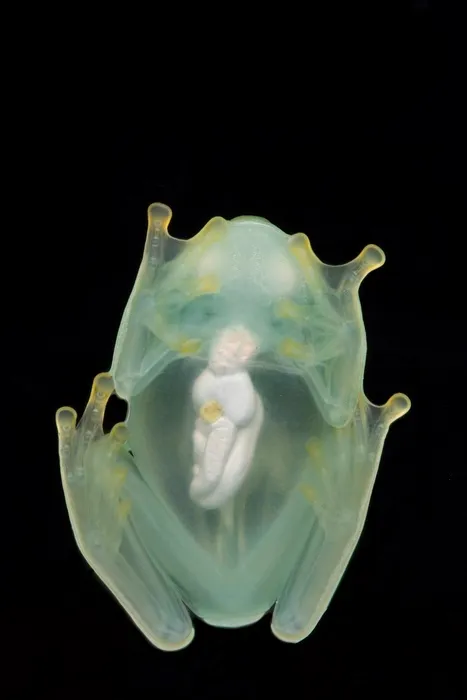There are many varied and clever forms of camouflage in the natural world, from the colour-changing prowess of chameleons and cuttlefish to the mimicry of orchid mantis’ and leaf-tailed geckos, to the eye-boggling spots and stripes of zebra and tigers.
But one of the weirdest has to be the transparent animal.
Why are some animals transparent?
One of the most out-the-box solutions to the problem of being seen has to be becoming practically invisible however. Although not true of every animal on this list (looking at you barrel-eye fish), the primary reason for an animal evolving to be see-through appears to be to avoid notice from predators.
By letting light shine through them, blurring their outlines, and blending in, these unconventional animals manage to avoid detection and increase their chances of survival. Read on to find out more about our favourite see-through, transparent animals.
10 transparent animals
Glass frogs

Native to Central American rainforests, glass frogs (one of the world's weirdest frogs) are a family of frogs that have transparent bellies and chests. Their internal organs including their heart pumping blood and food moving through their digestive tract can be clearly seen through their skin.
This translucency does have an important purpose, in that it allows them to blend in more seamlessly with their surroundings. The clear skin underneath and on the legs paired with an opaque green back acts as a form of camouflage, blurring their outline and making them more difficult to spot on leaves.
Fascinatingly, it has recently been discovered that this clever camouflage goes even further, with glass frogs possessing the ability to strategically remove red blood cells from circulation when needed, and store them in their liver for a while. This makes them look even clearer and more see-through, as red blood cells are what give blood its vibrant colour.
Sea angel (Gymnosomata suborder)

Angelic as they may look, these curious creatures are actually slugs! Sea slugs to be precise. Unlike many other sea slugs that can only crawl along the sea bottom, sea angels are able to freely swim through the water by flapping their transparent fleshy ‘wings’.
They are closely related to sea butterflies who have larger wings and often have shells. Despite their diminutive wings sea angels are much stronger swimmers, able to propel themselves through the water swiftly and gracefully. They are also formidable predators, feeding on unfortunate (and slow) sea butterflies primarily. When they come into contact with prey they grab them with tentacles protruding from their head and hook them in with specialised appendages, prising the sea butterflies out of their shell and into the angel’s gut.
Glasswing butterfly (Greta oto)

Similarly to glass frogs, the transparent wings of the beautiful (and aptly named) glasswingbutterfly allow them to camouflage and better avoid predators. During flight, they blend into the background and are very hard to spot. Such perfect transparency is achieved through a combination of factors.
Firstly, their wings lack the densely packed pigmented scales that are usual in butterflies. Instead, the see-through membrane of their wings is overlaid with sparse, spindly scales leaving gaps for light to pass through.
The membrane itself has anti-glare properties thanks to a waxy coating. More light passes through the wings than reflects off it, softening the glare and making them virtually invisible. The anti-reflective properties of these extraordinary wings may inspire innovative coatings for camera lenses, solar panels and other devices.
Ghost shrimp (Palaemon paludosus)

This species of freshwater shrimp, also known as glass shrimp, can be found in the southeastern United States. They are considered an important keystone species, as they are an crucial prey item for many birds and fish.
As with the other creatures on this list their transparency is believed to be a predator avoidance strategy, with their see-through bodies able to blend in with the surrounding water and vegetation. Their unique appearance has made them popular aquarium pets. Because they feed on algae, they also help keep tanks clean.
Namib sand gecko (Pachydactylus rangei)

The only reptile on our list, this little lizard is a master of camouflage, with its pale pink and brown nearly translucent skin blending in with the sand of its desert home. It is also an example of biofluorescence - a phenomenon that occurs when light is absorbed at high energies by plants and animals and is then reemitted at a lower energy.
This results in a fluorescent, brilliantly coloured glow. In the case of these geckos, the skin around their eyes and along their flanks glows a bright neon-green under moonlight.
This would seem to counteract their camouflage abilities - hard to blend in when you are glowing green- but is thought to have a different important function, long-distance communication with other members of their own species.
The glowing patches, placed on the sides of the body would be highly visible to other geckos, but not to predators with a birds-eye view, and may allow them to see each other and meet up.
Indian glassy fish (Parambassis ranga)

These transparent fish are native to South Asia, living in fresh and mildly brackish water, including marshes, lakes, rivers, and manmade impoundments such as reservoirs. They are quite extraordinarily see-through, with their entire spine, other bones, and internal organs clearly visible. Like ghost shrimp, their appearance has made them a popular fish tank pet.
This has however unfortunately led to a cruel practice in which some sellers try to make them even more attractive to hobbyists by injecting them with various coloured dyes. These ‘painted’ fish are sold as natural and are referred to as “disco fish” but in reality, the dye is not permanent, fading away after a few months, and is harmful to the health of the fish.
Barreleye Fish
These spooky-looking deep-sea fish have perhaps the strangest and most ingenious form of transparency. They are not see-through all over, but just the skull and the skin on the head and most of the face. And what is most prominently visible through this weird window are their perhaps even weirder eyes - bright green and tubular -definitely worthy of a place on both our weirdest fish and weirdest animals lists.
But let alone the colour and shape, the strangest thing about them is that they are on the inside! Barreleye fish are the only animal known to have eyes beneath the skin inside its head. Because of their dark deep home these eyes have to be incredibly sensitive, and are able to pick up movement even in the near- blackness. The transparent window in the top of their heads allows them to handily point their eyes upwards to look for the silhouettes of prey swimming above them, as well as rotating forward when needed.
Golden tortoise beetle (Charidotella sexpunctata)

As a group tortoise beetles are pretty out there. For example, many of the larvae carry a so-called ‘umbrella’ that they make out of their own faeces, thought to be used for protection.
Their most distinctive feature however is a domed carapace that looks like the upper shell of a tortoise (hence the name). This may be smooth or covered in spines. It may also be either vividly and solidly coloured with combinations of spots, stripes, and metallic hues, or be able to rapidly change colour, or in some species be almost completely transparent.
One particularly beautiful example is the species Charidotella sexpunctata, which has a gloriously bright gold body visible through a translucent domed carapace.
Daphnia

Taking the prize for by far the smallest animal on the list, daphnia are a genus of small planktonic crustaceans, measuring just 0.2 to 6.0 mm in length. Sometimes called water fleas (due to the jumping motion that they swim in), they can be found in various different types of aquatic environments, from swamps to freshwater lakes and ponds.
Because of their dominance and abundance within zooplankton, they are considered to be a vital part of many food chains, sustaining a great number of animals further up the feeding hierarchy.
Like many on this list, their transparent appearance functions as a useful camouflage, allowing them to blend into the surrounding water and better avoid predators like fish. This is particularly useful for a slow-moving animal like daphnia.
Glass eels (Anguilla anguilla)
The last on our list is not a species in and of itself, but rather a life stage of a species - the European eel to be precise. Glass eels are just one of the many different forms these eels move through on their journey to adulthood. After hatching from tiny spherical eggs in the Sargasso sea, the first form is what is known as leptocephali.
- How do eels mate? Once believed to spontaneously spawn, here's how they do it
- Meet the eel that makes an astonishing 6,000 mile journey, from European rivers to the tropical Sargasso Sea - and back again
These tiny, flattened (and also transparent) larvae then develop into glass eels. This stage is much more recognisable as an eel than the previous one, with glass eels now having the distinctive serpentine body of the adult form, only on a much smaller scale (around 3-6 centimetres).
They are almost completely see-through, with their bones and organs visible beneath the skin. Unfortunately, this life stage is considered a particular delicacy by some people, and there is a vast illegal trade in glass eels for human consumption. Overfishing of glass eels is one of the major threats to the European eel, a species that is classified as critically endangered.
More weird and wonderful wildlife






